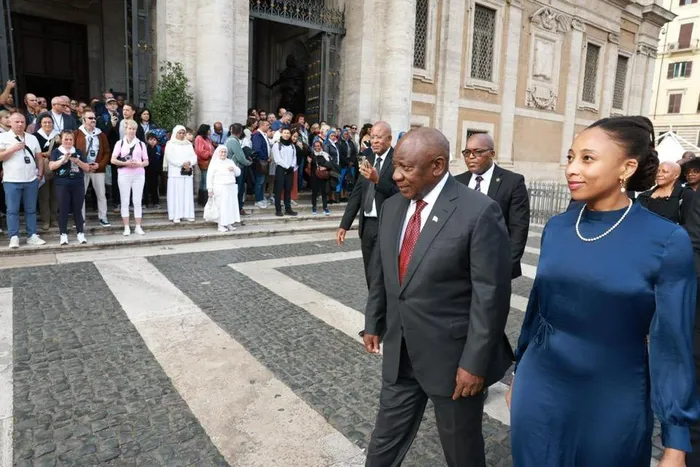Political meaning behind Cyril's Vatican visit with daughter

The Vatican photographs of President Cyril Ramaphosa and his daughter Keneilwe served a dual purpose. They humanised the president, offering a contrast to the country’s more negative news cycles potholes, power outages, and rising living costs, says the writer.
Image: PRESIDENCY
PRESIDENT Cyril Ramaphosa and his daughter, Keneilwe Ramaphosa, were seen this month at St Peter's Basilica in Rome.
While on the surface this appeared to be a father enjoying a moment with his child, for those familiar with South African politics, it suggested far more than a simple family outing. In a nation where political gestures are rarely accidental, this scene functioned as a subtle yet deliberate introduction of Keneilwe to the public sphere a "soft launch" disguised as casual sightseeing. The moment hinted that the Ramaphosa legacy could extend beyond Cyril’s current tenure in the Union Buildings.
President Ramaphosa had kept his family out of public view until recently. This approach stood in contrast to a political environment where public exposure and orchestrated photo opportunities are the norm. The composure and confidence Keneilwe displayed during the official visit was no accident, but rather the result of careful planning. The introduction set against the backdrop of marble, ritual, and the moral gravitas of the Vatican was quietly significant, signalling the potential for continuity in leadership without making any overt declarations.
As South Africa navigates an era defined by the Government of National Unity, President Ramaphosa’s political future increasingly relies on coalition-building rather than the traditional strength of the ANC. In this context, personal branding has become crucial. Politicians approaching the end of their careers often reflect on the legacy they will leave behind. Some people depend on established policies, while others place their trust in individual personalities. Ramaphosa appears to be assessing a third route establishing a lineage, but with plausible deniability.
The choice of the Vatican as the setting for this subtle political performance was both strategic and evocative. Every aspect of the Vatican reflects its rich heritage, and its leadership carries deep spiritual meaning. Against this grand backdrop, even the most pragmatic political message can take on the aura of divine succession. The “soft launch” of Keneilwe through carefully managed imagery allowed the public to consider the idea of dynastic continuity, without committing to it directly.
These Vatican photographs served a dual purpose. They humanised President Ramaphosa, offering a contrast to the country’s more negative news cycles potholes, power outages, and rising living costs. At the same time, the images posed a question: could the Ramaphosa name continue to hold significance beyond Cyril’s presidency? South Africa has seen similar stories before families like the Mandelas, Sisulus, and Mbekis have all passed down political influence across generations. The Ramaphosas seem to be crafting their own, more understated version of this tradition, one that leans less on struggle-era nostalgia and more on contemporary symbolism.
However, South Africans are discerning and not easily swayed by carefully staged family imagery. More individuals can recognize when political acts are staged, quickly detecting when something is intentionally orchestrated rather than truly spontaneous. There is a risk that this Vatican moment, designed to convey warmth and legacy, could instead ring hollow amidst the country’s pressing challenges: dysfunctional municipalities, youth unemployment exceeding 32 percent, and food prices that put basic groceries out of reach for many.
Despite these risks, the Vatican setting was a clever choice. It has the power to disarm cynics, transforming politics into something resembling a pilgrimage, and recasting leadership as a moral calling. In such a setting, a father walking with his daughter transcends mere family time; it becomes a symbol of faith, continuity, and grace imagery that blends humanity with mythmaking, and that every politician aspires to achieve.
Of course, there remains the possibility that the scene was simply a father sharing a meaningful experience with his daughter, and that the public’s tendency to interpret every gesture through a political lens reveals more about society than about the individuals involved. In South Africa today, where every move is scrutinised and even quiet moments attract notice, innocence has become about as rare as reliable electricity or reasonably priced food.
Whether or not Keneilwe Ramaphosa has political ambitions is secondary. The power of the image now lies in its circulation, analysis, and preservation within the national consciousness. It joins the ongoing narrative where politics, family, and spectacle intersect. Even if the next chapter is unwritten, the stage is already set and the performance continues.
Cyril Ramaphosa’s walk through the Vatican was not just another diplomatic engagement. It was a meticulously crafted moment, rich with symbolism and laden with political meaning.
In South Africa, the political show is perpetual; it simply changes costumes, moving from robes to tailored suits, always keeping its audience engaged and wondering what comes next. The only real question is whether South Africans are still interested in the spectacle, or if they have begun to look elsewhere for inspiration and leadership.
Qwesha is a trade finance consultant with expertise in global commerce and risk management and regularly contributes to a number of publications.
CAPE TIMES